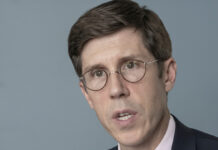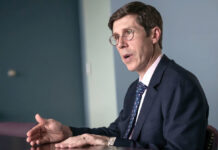WASHINGTON – Faster growth in some commercial real-estate markets underscores the risk of creating imbalances in the U.S. economy the longer the Federal Reserve keeps their benchmark interest rate close to zero, said Boston Fed President Eric Rosengren.
Along with a willingness by lenders to make large, riskier loans, “It would be a reason to maybe think about raising rates a little more quickly than I otherwise would, given the same unemployment and inflation rate,” Rosengren, who becomes a Federal Open Market Committee voting member next year, said in an interview with the Financial Times published Sunday.
His comments echo those made in a Nov. 9 speech in Portsmouth, R.I., in which Rosengren said a cost to keeping rates lower for longer is that investors seeking higher returns often take on too much risk to improve their returns. He pointed to sizable increases in the number of construction cranes in Boston and questioned the sustainability of such growth.
“As you get much closer to where you want to be for employment and inflation, there is some cost to having people reach for yield and wanting to take a little bit more risk with the kind of financial positions,” he told the FT. “That means when you do normalize, they are going to be more susceptible. So you want balance not only now but in the future.”
’Unequivocally positive’
The recent jobs report, which Rosengren said was “pretty unequivocally positive,” shows diminishing slack in the labor market that will continue next year as long as the U.S. economy grows above potential. While he also took comfort in stronger wage growth last month, the absence of further gains could be a reason for the Fed to raise rates more slowly, according to Rosengren.
As America’s central bank appears closer to raising rates with the rest of the developed world keeping them low, the dollar is strengthening, he noted. That means U.S. demand will have to pick up the slack for reduced exports.
“So far, our domestic demand has been strong enough to offset that weaker foreign sector,” Rosengren said. “If the divergence were to become large and have a big impact on the dollar, it probably means we would follow a more gradual path than we otherwise would.”
The FOMC next meets on Dec. 15-16 and policy makers will decide whether to raise the benchmark federal funds rate for the first time since 2006. It has held rates near zero since late 2008.












